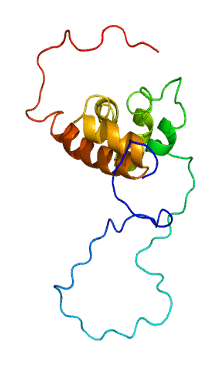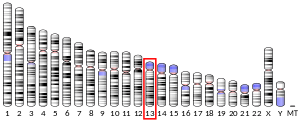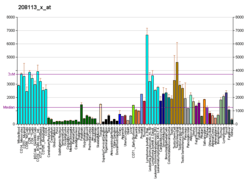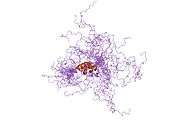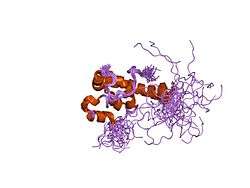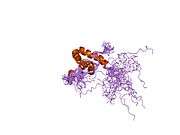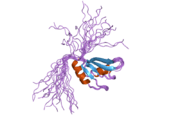Polyadenylate-binding protein 3 is a protein that in humans is encoded by the PABPC3 gene.[3][4][5]
Messenger RNA stability and translation initiation are extensively under the control of poly(A)-binding proteins] (PABP). See PABPC1 (MIM 604679) for background information.[supplied by OMIM][5]
Further reading
- Marques AC, Dupanloup I, Vinckenbosch N, et al. (2006). "Emergence of young human genes after a burst of retroposition in primates". PLoS Biol. 3 (11): e357. doi:10.1371/journal.pbio.0030357. PMC 1251493. PMID 16201836.
- Gerhard DS, Wagner L, Feingold EA, et al. (2004). "The status, quality, and expansion of the NIH full-length cDNA project: the Mammalian Gene Collection (MGC)". Genome Res. 14 (10B): 2121–7. doi:10.1101/gr.2596504. PMC 528928. PMID 15489334.
- Strausberg RL, Feingold EA, Grouse LH, et al. (2003). "Generation and initial analysis of more than 15,000 full-length human and mouse cDNA sequences". Proc. Natl. Acad. Sci. U.S.A. 99 (26): 16899–903. doi:10.1073/pnas.242603899. PMC 139241. PMID 12477932.
- Féral C, Guellaën G, Pawlak A (2002). "Human testis expresses a specific poly(A)-binding protein". Nucleic Acids Res. 29 (9): 1872–83. doi:10.1093/nar/29.9.1872. PMC 37253. PMID 11328870.
- Wiemann S, Weil B, Wellenreuther R, et al. (2001). "Toward a catalog of human genes and proteins: sequencing and analysis of 500 novel complete protein coding human cDNAs". Genome Res. 11 (3): 422–35. doi:10.1101/gr.GR1547R. PMC 311072. PMID 11230166.
- Hoshino S, Imai M, Kobayashi T, et al. (1999). "The eukaryotic polypeptide chain releasing factor (eRF3/GSPT) carrying the translation termination signal to the 3'-Poly(A) tail of mRNA. Direct association of erf3/GSPT with polyadenylate-binding protein". J. Biol. Chem. 274 (24): 16677–80. doi:10.1074/jbc.274.24.16677. PMID 10358005.
PDB gallery |
|---|
1g9l: SOLUTION STRUCTURE OF THE PABC DOMAIN OF HUMAN POLY(A) BINDING PROTEIN 1jgn: Solution structure of the C-terminal PABC domain of human poly(A)-binding protein in complex with the peptide from Paip2 1jh4: Solution structure of the C-terminal PABC domain of human poly(A)-binding protein in complex with the peptide from Paip1 2d9p: Solution structure of RNA binding domain 4 in Polyadenylation binding protein 3 |
